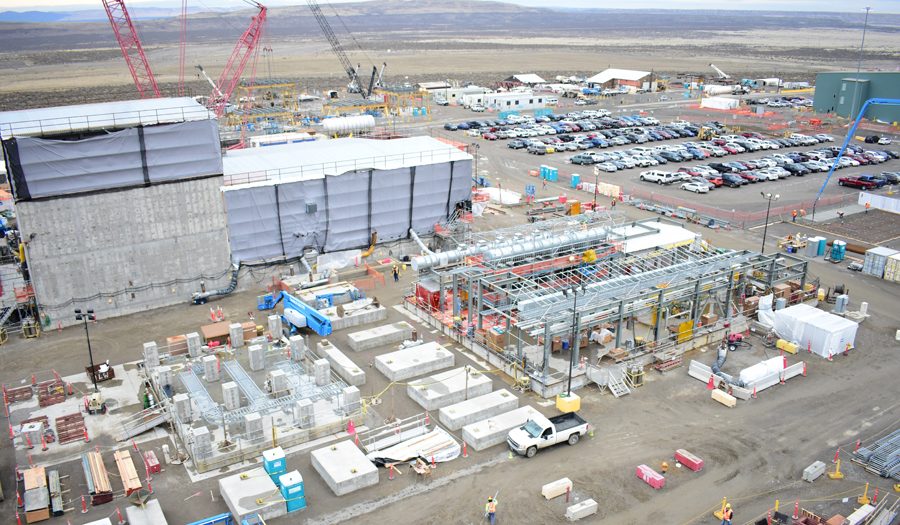
Home » Vit plant ramps up for next phase
Vit plant ramps up for next phase

May 16, 2019
Round-the-clock
staffing is in place at the Hanford Waste Treatment and Immobilization Plant as
Bechtel National Inc. prepares to process low-activity waste by 2023, but
possibly as soon as 2022. There hasn’t been 24/7 staffing at Hanford in more
than 20 years.
Earlier
this year, the analytical laboratory at the plant entered its startup phase,
marking the first major facility to begin full systems testing mode.
“We
are in phases we have never been before,” said Staci West, Bechtel’s
communications manager for the plant.
The
overall goal is to process nuclear waste at the site using vitrification, a
method of permanently disposing of waste by mixing it with glass-forming
materials.
The
planning and construction of the plant got underway nearly 20 years ago, at an
expected cost of $17 billion, with the end result being the world’s largest
radioactive waste treatment plant.
https://youtu.be/IisnBjFO9PU
A project commissioned by the U.S. Department of Energy,
the completed vit plant will process 56 million gallons of radioactive and
chemical waste currently stored in underground tanks, following decades of
plutonium production at Hanford. The existing tanks are not a long-term
solution for the waste, as dozens are leaking and pose a threat to the
environment.
The decadeslong project is a multi-phase operation,
beginning with construction, followed by startup procedures, and an eventual
transition to commissioning and operation. For example, the analytical
laboratory on the vit plant site was only ready to move into the startup phase
after 34 systems were tested, with the last being electrical. From there, the
equipment and systems will be tested meticulously to ensure they are in working
order before the lab enters the commissioning phase, which includes operations.
Startup testing at the lab is expected to finish this year.
The
first set of 22 commissioning technicians are on the job in the control room of
the low-activity waste, or LAW, facility. Working alongside eight supervisors
and four engineers, the staff will eventually grow to nearly 350 employees in
the next 18 months.
Commissioning technicians are cross-trained on
more than 200 systems in the LAW facility, effluent management facility
analytical laboratory and other support facilities. Training is done in a
17,000-square-foot building with a full-scale functional replica of the LAW
control room.
The
purpose of the lab is to confirm that glass produced meets regulatory
requirements and standards. Processing will take place during direct feed
low-activity waste, or DFLAW, operations, bringing the waste directly from the
tank farms, which are managed by Washington River Protection Solutions, and to
the LAW facility. It requires the two to work in concert with each other.
“WPRS
is also working to design and build the systems necessary to supply the vit
plant with a steady diet of waste to support eventual operations,” said Robert
Roxburgh, deputy manager of communications and public relations for WRPS. “The
tank-side cesium removal system will separate both cesium and undissolved solid
materials from radioactive tank waste, providing a low-activity waste stream
that can be sent to the WTP for vitrification.”

Benefits
of a DFLAW approach are touted as safe storage of long-term waste, reduction of
any short-term risks to the environment by targeting mobile constituents, and
the creation of additional double-shell tank space.
The analytical lab was intentionally built next door to
the LAW facility, where technicians within the lab are expected to analyze
about 3,000 samples each year. Since not all waste is identical, the process
will determine what materials should be mixed with each sample to create a
glass log that meets regulatory requirements. The logs will be stored on the
Hanford site until a national repository is identified.
Bechtel
and the Department of Energy are working to meet a court-ordered deadline at
the end of 2023 to begin treating low-level waste. This date was determined
through a consent decree in 2016, which set a legally-binding schedule to
retrieve waste from the tanks and continue construction of the plant.
Plant
operations were originally expected by the end of 2018 but after problems arose
with the high-level waste and pretreatment facilities, the project shifted
focus to DFLAW configurations instead. This now includes the Dec. 31, 2023,
deadline for treating LAW, and a Dec. 31, 2033, deadline for treating
high-level waste.
Goals
for the remainder of 2019 include delivering all DFLAW major equipment and bulk
materials, completing the startup of the analytical laboratory and installing
equipment necessary for the final support structure, the effluent management
facility, or EMF.
There
are 20 support facilities that make up the Balance of Facilities, or BOF, on
the campus, with 14 dedicated to low-activity waste and the remaining six to be
built in future phases to treat high-level waste. The EMF is part of the DFLAW
process, receiving secondary liquids generated from the LAW facility to be
treated and transferred to the liquid effluent retention facility, which sends
back any remaining concentrate to go through vitrification.
Bechtel
is planning to simulate a loss of power during a test planned in fall 2020 to
ensure the facility’s melters would remain functional despite a blackout.
Bechtel leadership calls this a “crucial” test toward moving into the operation
phase for the LAW facility. The melters are considered the heart of the
vitrification process since they heat the waste and chemicals so they may be
turned into glass form.
The
loss-of-power test is one of many processes described as “methodical,”
encompassing a series of reviews paired with rigorous documentation.
“As
we meet different milestones, we can do the next set that we haven’t done
before,” said George Rangel senior communications specialist at the vit plant.
Rangel
said as crews prepare to hand over any facilities from startup testing to the
commissioning phase, “workers are hands on to develop processes and procedures
that will govern their work.”
As
the procedures roll along, the plant’s workforce needs also shift.
Right
now, about 2,600 people work at the site, but eventually that number is
expected to fall to 1,500 to 1,800.
“Once
we start operations, there will be a steady workforce for DFLAW,” West said.
“It will be smaller than what was required to build it, but there will still be
a steady workforce.” This includes transitions from construction workers to
chemists, who will be needed on the commissioning team. Some of these chemists
currently are working inside a lab at Columbia Basin College to ensure workers
train on the same equipment they will eventually use in the analytical
laboratory.
“In
the next one to two months, some of those workers will begin working out of the
lab for the first time,” West said.
Startup and testing also recently got
underway for four utility buildings that are part of the support infrastructure
that make up the BOF on the vit plant site, containing 56 systems. The utility
buildings include the anhydrous ammonia facility, former glass storage
facility, chiller compressor building and steam plant building. All are
scheduled to complete the startup phase within 2019. Bechtel promotes that once
complete, the BOF will have a chilled water system that could cool 23,500
houses, a fuel oil storage that could fill the gas tanks of 11,500 cars and a
compressed air system that could fill the Goodyear blimp in three minutes.
About half of the BOF systems are in the commissioning phase, another 24 are in
the startup phase and the final five are preparing to be turned over from
construction to startup.
When complete, the “first-of-a-kind
project” will cover 65 acres and include four nuclear facilities covering
pretreatment, the analytical laboratory, LAW facility and high-level waste
facility, besides other operations and maintenance buildings, utilities and
office space.
The footprint of the plant itself
is equivalent to the size of 1.5 football fields and 12 stories high. Bechtel
describes the vit plant as a “feat of engineering and construction at an
unprecedented level,” making it the “largest undertaking of its kind and one of
the Department of Energy’s most technically challenging cleanup projects.”
Local News Hanford
KEYWORDS may 2019





